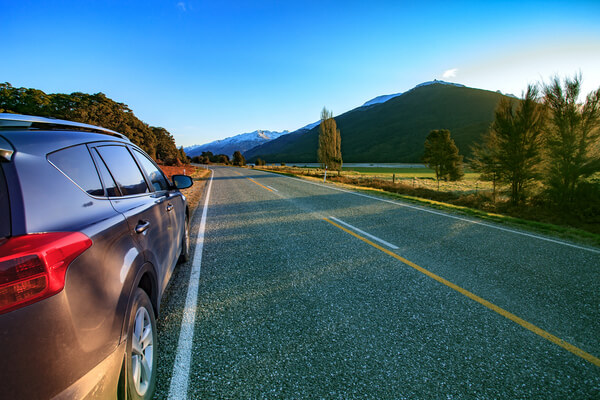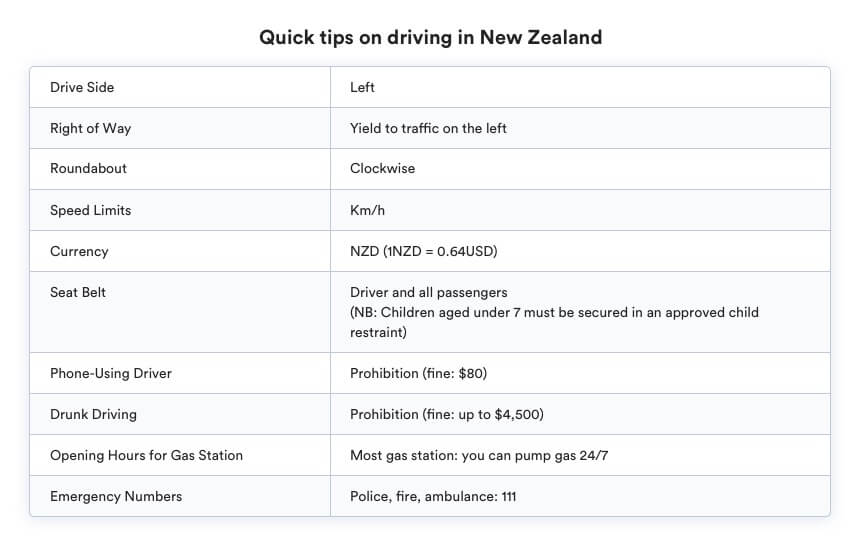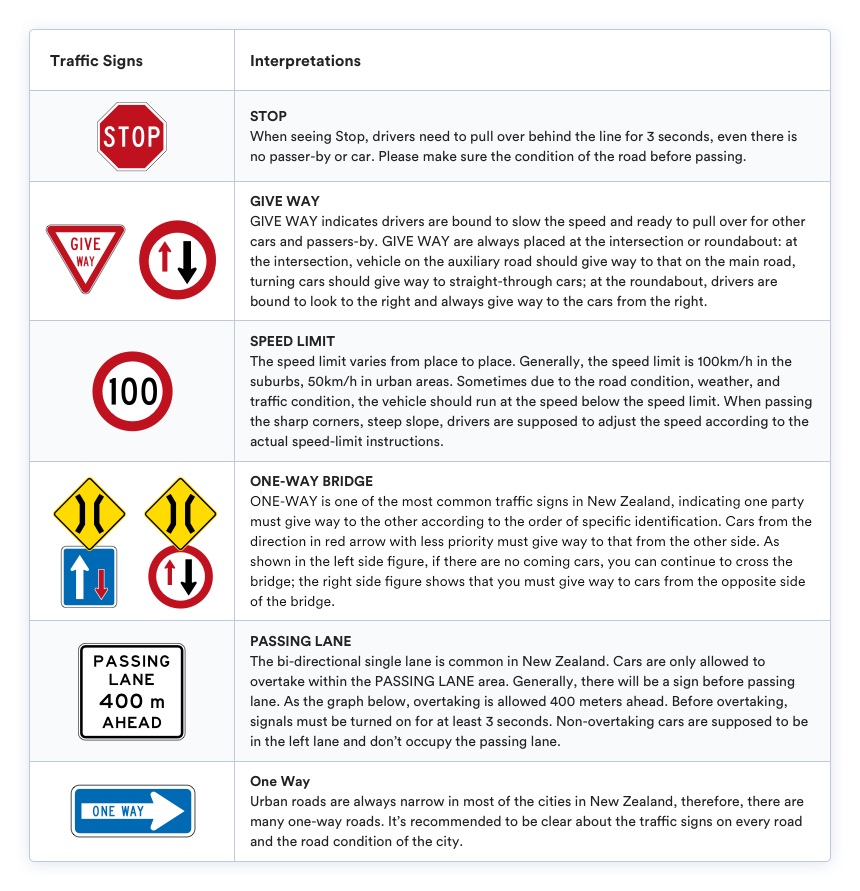It’s well-known that the best view in New Zealand is along the roadside. However, except for Christchurch, public transportation is underdeveloped in other cities. Therefore, a self-drive tour is the best option to explore New Zealand.
1. Driving Rules and Tips
- Speed Limits
i. Urban arterial roads – 60 km/h: including those through rural townships
ii. Rural area – 80 km/h: rural access roads, winding rural roads, and limited-access urban arterial roads
iii. Motorways – 110 km/h
- Traffic and Road Signs
For more information about New Zealand road signs, here is an infographic from QEEQ.COM.
2. Road Condition and Toll Roads
- Road Condition
National roads in New Zealand are mostly bi-directional single lanes. Only near the ‘important main road’ there is two-way four-lane and two-lane will be set up in important cities, such as Oakland and Wellington as well as in ports.
If possible, please avoid driving on the rocky road. If not, note that this section of the road may be very narrow, please always drive to the left and slow down or give way to oncoming cars. Please be careful that the dust will affect the sight and stone will break the windshield.
Expert tips: Please be cautious if someone straightens his arm and wave up and down, indicating there is a danger ahead.
- Toll Roads
Most of the highways are almost free of charge throughout New Zealand. Only a few, such as Northern Gateway Toll Road and Tauranga Eastern Link Toll Road, are one-way tolls. The fee varies from NZ$1.8 to NZ$ 2.3. There are always signs and instructions about alternative routes before toll roads.
Expert tips: It is suggested that when planning your journey, you can check in advance whether there is a toll road. If so, GPS can be programmed to avoid it. If it cannot be avoided, please pay promptly in different ways.
How to pay?
To smooth the flow of cars and improve efficiency, there are not toll stations on highways and cars are monitored by the live traffic camera.
Ways to pay are various in New Zealand. Drivers can pay the toll 80 days before or 5 days after passing the toll roads. Paying at the machine or online or through the telephone is common.
- Self-Service
Enter information like plate number. Credit cards and cash are both acceptable.
- Pay online
Steps1: Log in NZ Transport Agency website
Steps2: Enter plate number
Steps3: Enter credit card or visa
Steps4: Pay the charge
- Pay through telephone
Call 0800 40 20 20 and pay by credit card
Expert tips: If you don’t pay the toll in 5 days, the notification will be sent and there will be extra ‘administration fee’ and fine.
3. Gas
Gas price in New Zealand is connected to the international gas price, about NZ$1.8-NZ$2.2/liter. Diesel is about 10%-15% cheaper than gasoline.
There are many refueling brands in New Zealand, such as BP, Mobi, Z Energy, Challenge, Caltex, Alliance. Gas price varies from places to places. The types of gasoline in New Zealand: 91, 95/96 and 98. The larger the number of oil, the higher the quality of the oil and the more expensive the price.
When refueling in New Zealand, you can follow the instructions on the car or the fuel tank cap and fill the tank with the designated fuel. If you are not sure which fuel to choose, consult the branch staff when picking up the car. Generally, the cars should be fueled with 91 Unleaded, with a green oil gun. Diesel is marked with a black oil gun and ‘Diesel’.
Expert tips: Please be careful not to fill the tank with the wrong fuel. If you refuel with the wrong fuel, please contact the branch as soon as possible to clean up the fuel tank and the fuel system and conduct an overall inspection of the engine. Don’t start the car in haste in case of car damage.
How to pay?
i. Self refueling
The basic steps of self refueling are as follows:
Step1: Stop the car near the fuel pump, select the oil type
Step2: Pick up the fuel pump to the fuel tank, pull the handle
Step3: The price and the amount of oil will be shown on the screen
Step4: The handle will pop up when the fuel tank is full, or lose the handle if the charge has reached to a certain amount, the fueling process will be stopped
Step5: Put back the pump, close the lid, and remember the number of the oil pump
Step6: Enter the store in the oil station and inform the staff of the number. Pay by card or in cash is accepted
ii. Refueling by credit card
In some places, there is no manual charge and only use a credit card.
The refueling process of credit card payment is as follows: insert the card to the machine, take out the card after reading, then enter the password according to the instructions. And you can refuel your car and then print the receipt.
When the credit card is being scanned, you may receive a message of consuming NZ$100-200. Please note that this charge is pre-authorization and it will charge the actual amount after refueling.
Expert tips:
1. With large territory and few populations, the price of petrol is high and it’s inconvenient to fill the fuel in a remote area. It’s suggested that before the long journey please ensure the full oil tank.
2. Please remember to ask for a receipt when refueling. Some oil stations only give the receipts if you ask.
3. Please note that only you can start the car after payment; otherwise, drivers may be charged.
4. Parking
- Public Parking Lot
There are exclusive parking lot near the shopping centers and supermarkets. The scenic spot and the busy area are generally charge-free parking area. In addition to the city center and popular cities such as Wellington, Auckland, it is convenient to park in other places.
- Self-Parking Area
The parking area marked with ‘PAY HERE’ is usually tolled, but not for the night. More details refer to the timetable.
- Free Parking within a Specific Period
There are many free parking lots with various time limitations in New Zealand. Time-limited parking signs like P5, P10, P30, P60 will be set there. The number indicates the free parking period. As shown below, from Monday to Friday it can park for 60mins for free. Generally, in this area, the staff will mark the beginning time on the tires; and fine the drives if overtime.
How to pay?
i. Self-payment at the roadside
Charging varies from places to places, from NZ$3 to NZ$8. Credit cards and coins are acceptable.
Steps are as follows:
Step1: Put in coins /insert the card
Step2: Select the period
Step3: Confirm
Step4: Print the receipt
Step5: Put the receipt at the windshield
ii. Pay at the parking lot
You can pay the charge by yourself or by the staff.
Self-payment always pay after parking, the steps are as follows:
Step1: Get the tickets at the entrance
Step2: Park the car
Step3: Put the tickets in the self-payment machine
Step4: Pay the charge
Step5: Print the receipt and parkin tickets
Step6: Leave the tickets at the exit when leaving
Please note that the parking tickets should be taken with you, not in the car.
Expert tips: Please remember to put the parking tickets at the windshield for inspection. If you lost it, regardless of parking time, you will be charged at the highest price.
5. Tickets
The rental company may pay the fine for you if there is unknown fine when coming back. But usually it is more expensive than the fee for breaking rules, which is included administration fee from the rental company.
How to pay?
i. If the violation is photographed by a road camera, the car rental company will contact the customer later, and charge the fine from the credit card and provide a receipt according to the procedure.
ii. If the violation (such as exceeding the speed limit) is caught during the trip, the customer will be required to pull over, show their driving license and do an alcohol test. Then the police will issue the ticket. The fine should be paid within 28 days, by calling 0800 4 FINES to inform the info of the credit card to charge the fine; or by logging in the website on the ticket to fill in the needed info and pay the fine. Or the customer can pay the fine at the on the site at the designated place. Each spot has a processing spot.
If there is no illegal record, the deposit will be unfrozen and returned to the credit card of the main driver.
Expert tips: It would be better to check whether there is a toll road and toll bridge while traveling. And some possible illegal behaviors. If there is a fine, pay as soon as possible or a higher extra fee will be charged.
Visit QEEQ.COM now.
QEEQ.COM guarantees the most competitive car rental deals for your travel and the secret is our Price Drop Protector program! We can automatically track your rental rates and RE-BOOK you if prices drop! See how our customers love this feature here.




